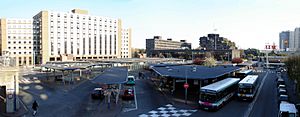Île-de-France tramway Line 1 facts for kids
Quick facts for kids Tramway T1 |
|
|---|---|
  |
|
 |
|
| Overview | |
| Status | Open |
| Owner | RATP |
| Termini | Asnières - Quatre Routes Gare de Noisy-le-Sec |
| Stations | 37 |
| Service | |
| Type | Tram |
| System | Tramways in Île-de-France |
| Operator(s) | RATP |
| Rolling stock | 35 TFS |
| Ridership | approx. 30 million journeys per year |
| History | |
| Opened | 6 July 1992 |
| Technical | |
| Line length | 17 km (11 mi) |
| Track gauge | 1,435 mm (4 ft 8 1⁄2 in) |
The Île-de-France tramway Line 1, often called T1, is a key part of the modern tram network in the Île-de-France region of France. This tram line connects Noisy-le-Sec station and Asnières-sur-Seine. It runs along the northern edge of Paris, serving many suburbs.
Line T1 is about 17 kilometers (10.5 miles) long and has 37 stations. It was the first modern tram line to open in the Paris area, starting service in 1992. The line has been made longer with extensions in December 2003, November 2012, and October 2019.
The RATP (which runs public transport in Paris) operates Line T1. It's managed by Île-de-France Mobilités, the public transport authority for the region. The T1 tram is very popular, carrying around 188,000 passengers every day in 2015. This makes it the second busiest tram line in the network.
There are plans to extend Line T1 even further. To the west, it might go towards Colombes, which would allow people to connect to Line T2. To the east, an extension towards Val de Fontenay is planned. This eastern extension will be built in two parts. The first part will connect Noisy-le-Sec station to Montreuil (Rue de Rosny).
Contents
History of the T1 Tram Line
How the T1 Line Grew
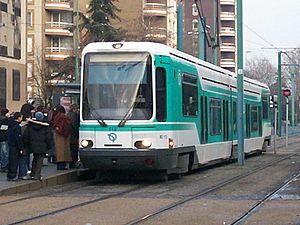
The T1 tram line has grown quite a bit since it first opened. Here's a quick look at its journey:
- July 6, 1992: The tram line first opened between Bobigny-Pablo Picasso and La Courneuve-8 Mai 1945.
- December 15, 1992: The line was extended west from La Courneuve–8 Mai 1945 to Saint-Denis station.
- December 15, 2003: An extension to the east opened, connecting Bobigny-Pablo Picasso to Gare de Noisy-le-Sec.
- November 15, 2012: The line was extended further west from Saint-Denis station to Les Courtilles.
- October 12, 2019: The most recent extension opened, taking the line west from Les Courtilles to Asnières-Quatre Routes.
The Return of Trams to Paris
The Île-de-France tramway Line 1 was very important because it brought trams back to the Paris region. Trams had not been used there since 1957. Building this line was a big achievement, especially after many discussions between local governments and the towns the tram would pass through.
In the 1970s, city planners wanted to improve transport links between different suburbs around Paris. They noticed that traffic was getting very bad on some roads. So, they started looking for new solutions.
In 1977, a group called the Institute for the Management and Urbanism of the Île-de-France Region (IAURIF) began studying how to connect key suburban areas. They suggested using a tramway. Trams are better than buses because they can carry more people. They also have other benefits like being quieter, cleaner (no pollution), and easier for people with disabilities to use because of their low platforms. Trams seemed like the perfect choice for connecting suburbs, as there were too many passengers for a bus line but not enough to build a full metro line.
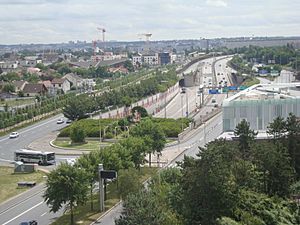
By 1980, the IAURIF worked with the RATP to study the connection between Saint-Denis and Bobigny. At first, the RATP wasn't sure if enough people would use the tram to make it worthwhile. However, the local government of Seine-Saint-Denis strongly supported the project.
In 1982, the RATP and local authorities studied the idea more closely. They found that a tram line would help many populated areas that were facing economic changes. The proposed tram route would connect with three metro lines and one train station, making it very useful for people traveling around Paris.
A study compared three options: a tram, a long bus, and a long trolleybus (an electric bus that gets power from overhead wires). The study showed that building a tram would cost the most at first. However, it would be cheaper to run per passenger after the first year and would attract more riders. The study also highlighted that modern trams are very appealing to the public. They can even help improve the neighborhoods they serve by reducing car traffic. Because of these benefits, the project was approved in 1983 and 1984.
It was expected that about 55,000 passengers would use the tram every day. Trams would run every four minutes during busy times. The line was planned to be 9.1 kilometers (5.6 miles) long with 22 stations. It was inspired by the successful tram system in Nantes.
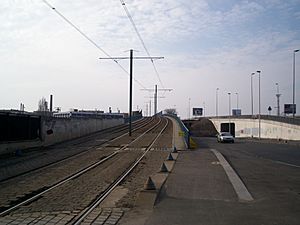
The project received funding from the state and local regions. After public discussions in 1984, the plan was approved. The RATP was put in charge of running the new line. Construction was expected to finish by 1988.
Challenges and Changes
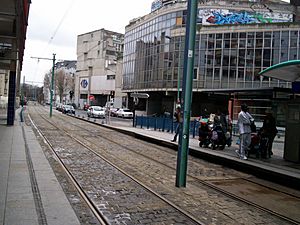
In 1986, there was a change in government. The new government wanted to reduce public spending, which put the tram project at risk. There was a debate about whether the tram was truly the best solution. The RATP studied the idea again and suggested that a special bus lane could replace the tram. However, this option had problems: buses would be slower, less frequent, and restarting the planning process would cause big delays. Also, local governments might not agree, which could lead to funding issues. In the end, the tram project moved forward.
Route of the T1 Tram
See also
 In Spanish: Línea T1 (Tranvía de París) para niños
In Spanish: Línea T1 (Tranvía de París) para niños


